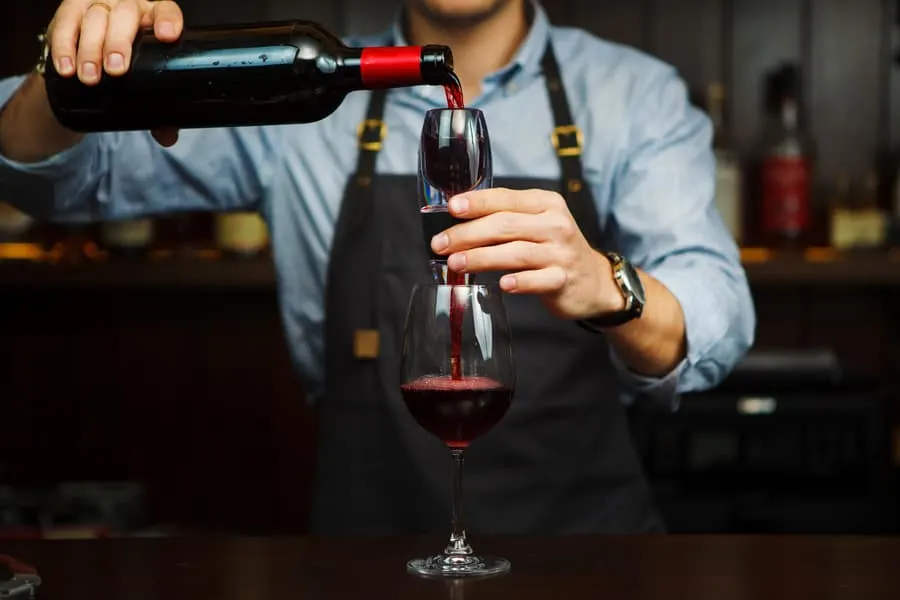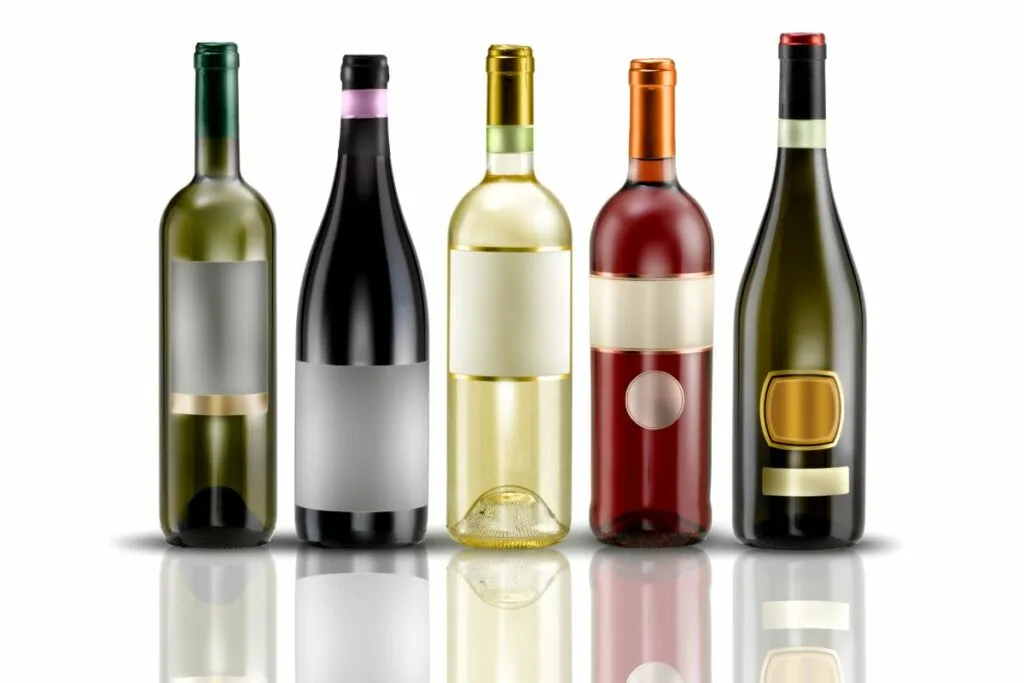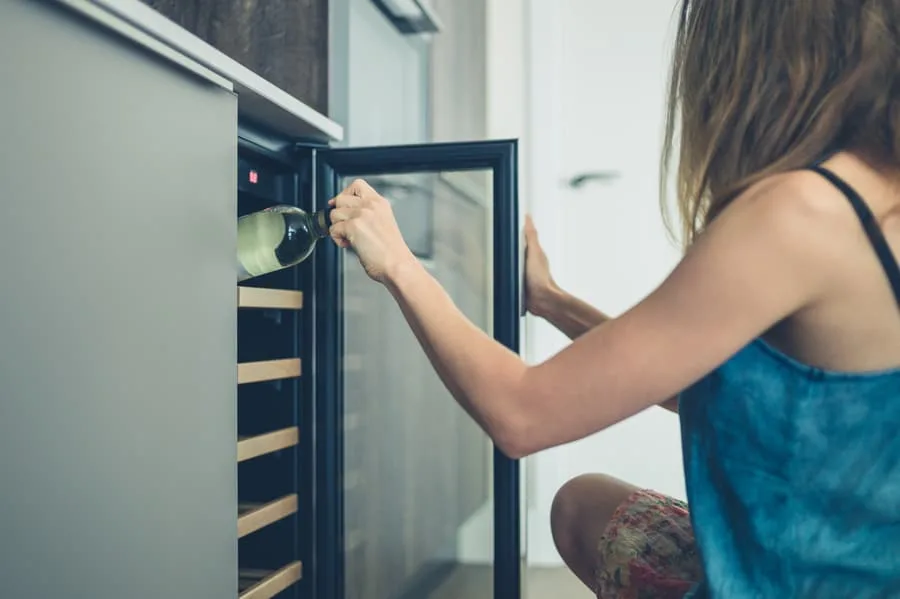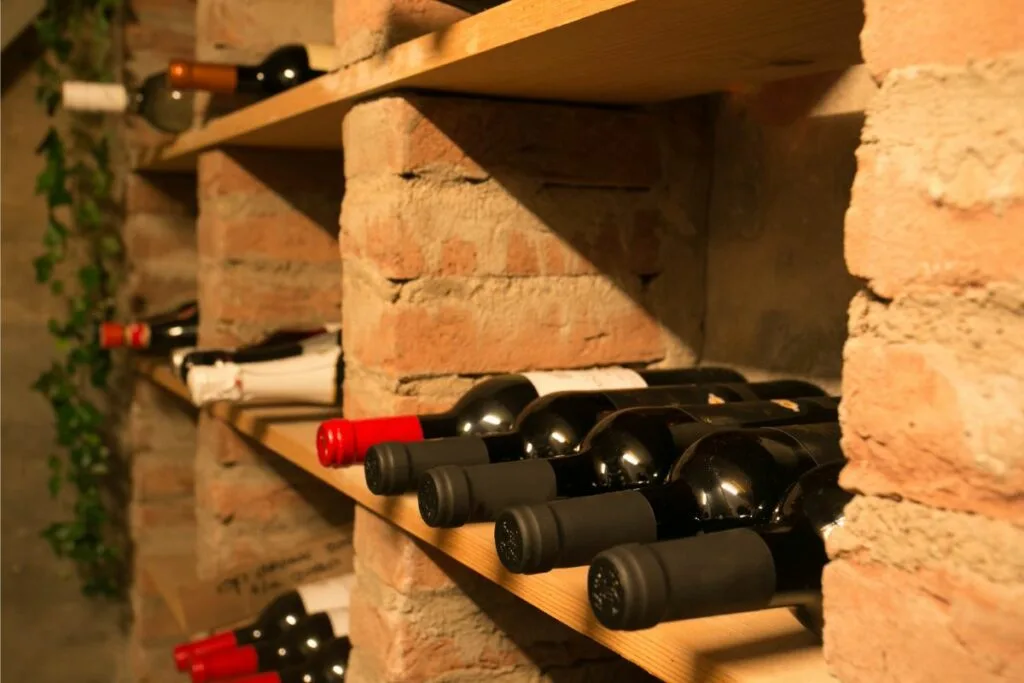As an Amazon Associate, I earn from qualifying purchases with no additional costs for you.
Many people wonder about the best way to store wine long-term. One factor you need to take into account is light and its effect on wine aging. Many wine lovers, therefore, wonder if wine is best kept in the darkness away from potentially harmful light.
Wine should be stored in the dark if at all possible to prevent significant light damage that could ruin your wine. Light can turn a good wine bad and catch your beautiful red to burn a shade of brown with the color to match.
Many consumers are unaware of the principles of storing wine at home and end up damaging previously delicious bottles of wine. The most tragically avoidable consumer mistake is not regulating the light and temperature of their wine storage space.
In this article, we will shed some light (pardon the pun) on the importance of light and temperature when storing wine, and provide some useful guidelines on how to make smarter wine storage decisions in the future.

TIP: If you want to check out the best refrigerator for wine storage, I recommend trying out the Avation (18 bottles) compressor refrigerator with Wi-fi smart app control cooling system. You can find this refrigerator by clicking here (Amazon link).
How Does Light Affect Wine?
Improper light and temperature in a wine storage space are the number one culprit in turning a wine. Why is this? If a wine is exposed to excessive light or heat, the aging process is accelerated and the wine is likely to develop faults.
If the exposure to light or heat during storage is minimal, this might simply result in a wine with slightly softer tannins and a slight dulling of the wine’s fruit character.
But if the exposure is more severe, you may be left with a wine that has lost all of its original characteristics and developed new, unpleasant ones
Temperature is a critical factor in wine storage. A cool temperature–the ideal range is between 45° F and 65° F–will allow a wine to age gracefully. In a study conducted by Wine Perspective, the wine was proven to age at wildly different rates when stored in varying temperatures.
For the first set of wines in the study, the temperature was increased from 55° F to 59° F, and the rate of aging was 1.2-1.5 times faster than before. For the second set, the temperature was increased from 55° F to 73° F, and the rate of aging was between 2.1 and 8.0 times faster. In
In the last set, the temperature in the cellar was raised from 55° F to 91° F, and the rate of aging increased to an astonishing 4.1-56 times faster.
In other words, one month of aging at 91° F was equivalent to between four months and eighteen years of age at 55° F (Pandell, How Temperature Affects the Aging of Wine).
Does this mean you should try to speed up your cellar’s aging process at home by leaving your wine out in the sun? No, please don’t! Unfortunately, the aging we’re talking about is not the fun kind that allows fabulous tertiary aromas to develop.
Instead, the flavors become dull and oxidized and the color fades and turns brown. Wine becomes “cooked” when exposed to high temperatures.
TIP: To find out more details on why your wine could turn brown, read this article. Do you know the correct way to store red wine? This article explains everything that you need to know.
Just like when you’re making jam and transforming raw fruit into a sugary stew, a wine that is exposed to heat will become more densely fruity and give the sense of ripening further in the bottle.
Eventually, those “cooked” flavors will give way to vinegar flavors. This is why you should never leave your wine in a hot car on a sunny day.
Recommendation box: Everything you need to enjoy your wine as much as possible. All recommended products are personally tested and regularly used by experts from this website (Amazon links):
> Ivation Wine Cooler – Energy-efficient wine cooler for 18 bottles with Wi-fi smart app control cooling system.
> Wine Rack – Beautiful, elegant wood rack for up to 7 bottles and the choice of vertical or horizontal storage.
> Durand Wine Opener – Classic vintage wine opener (we like all these classic staff).
> YouYah Iceberg Wine Decanter – The most beautiful and handy wine decanter we personally use.
> Bormioli Rocco Wine Glasses – A set of eight elegant and traditional wine glasses made in Italy.
> Vintorio Wine Aerator – Simple but really useful wine aerator for a reasonable price.
> The Original Vacu Vin Wine Saver – The best wine saver on the market in a package with two vacuum stoppers and two wine servers.
And if you want to become a true connoisseur of wine, we recommend reading the book Wine Folly: The Essential Guide to Wine (Amazon link), where you will find all the information you need about winemaking, wine varieties, flavors, and much more.
Along with temperature, light, particularly ultraviolet light, can initiate an oxidative reaction in a wine, muting its varietal characteristics and turning the wine’s color an orangey-brown hue.
Oxidation occurs when a wine is exposed to oxygen, whether intentionally or unintentionally. While oxidation can be an intentional and favorable technique in the production of certain wine styles (Sherry, for example), an excess of oxygen post-bottling is an unwelcome guest.
Very small amounts of oxidation will always occur when aging wine in a bottle, but we want that process to be as slow and controlled as possible. There are organic compounds naturally occurring in wine that help to protect wine from oxidation as it ages.
For example, antioxidants and tannin help to protect wine from oxidizing too quickly. But light, especially UV light, degrades these compounds and makes the wine vulnerable to deterioration.
Because those compounds are key to the aroma, flavor, and structure of a wine, an oxidized wine will lose its varietal characteristics and become a shell of what it once was.
If you needed another reason to declare light the ultimate enemy of your beloved wine collection, it can also create a wine fault called dimethyldisulphide, or “light-strike.” Light-strike occurs as a result of exposure to light, usually UV light, and causes the wine to smell like wet wool or cooked cabbage.
Many people mistake light-strike for cork taint or another wine fault, and consumer awareness about light-strike is minimal. So warn all your friends about its danger!
Light-strike most commonly happens when the wine is stored in the sun or near a window–in fact, light-strike can strike in as little as 60 minutes of light exposure.
So next time you see a beautiful display of bottles sitting in the window of a wine shop, think twice before you shell out the money for a pricy bottle that may be faulty.
Certain wines are more at risk of the light strike than others. Because of their tannin structure, red wines are more protected from light strikes. Delicate white wines, however, such as Champagne, Pinot Grigio, and Sauvignon Blanc, are extremely at risk.
For a complete breakdown of the ideal conditions for long-term wine storage, please check out this helpful article I wrote. This is vital information to understand better wine storage.
How Packaging Affects Light Damage to Wine

For light to damage wine, it has to first penetrate through the glass bottle holding the wine. This barrier can provide a great deal of protection to avoid turning your wine.
When it comes to wine bottles, though, not all are created equal. By far the best option for protecting wine in the dark, amber-colored glass bottle. Amber glass protects from light and the full UV spectrum.
However, despite the superior protection amber-colored glass bottles provide, they are very infrequently chosen by winemakers. Amber glass is more commonly used for beer bottling.
Green-colored glass is the traditional wine industry choice, and they do a decent job of protecting from light and UV rays but not as good as amber-colored glass.
Green-colored glass is most expected and appealing to customers, and because many consumers are not interested in long-term bottling aging, they can be sufficient in protecting the wine from damage until they are quickly drunk.
TIP: Do wine bottles break easily? Find out in this article. What do you do with excess box wine? Can you freeze it? Read this article to find out.
Most wine purchased is consumed within 24 hours, after all. Some bottles are not tinted at all, however, leaving the wine completely exposed to light. Clear bottles are unfortunately a fairly popular packaging choice for white, rose, and sparkling wine.
For some wines, like roses, having a clear bottle helps to present a visually striking product to the customer. Clear bottles, however, leave wines completely susceptible to light strike.
TIP: A suitable wine glass is the basis for enjoying well-being while drinking your favorite wine variety. Here are our favorite ones (Amazon link):
- Bormioli Rocco Crystal Wine Glasses: A set of eight elegant and traditional wine glasses made in Italy for a reasonable price.
- Riedel VINUM Wine Glasses: Luxury set of two wine glasses suitable for any occasion. We just love them!
- Schott Zwiesel Tritan Crystal Glasses: If you like unusual alternatives, a set of six stemless glasses made of crystal glass.
In a study conducted by Glass Technology Services and the University of Sheffield, clear glass allowed around 90% of light on the upper UV wavelength of 350nm to pass through the glass, green glass allowed 70% of light through at 370 UV wavelength, and amber glass protected from the entire UV spectrum (Wrap.org.uk, “Glass Wine Bottles and UV Light”).
Champagne, a very delicate wine frequently sold in clear glass bottles, is the most common victim of light-strike. Because of this, many producers choose to wrap each bottle in colored plastic wrap, which provides some additional protection from light exposure.

Do different types of light affect wine differently, and how much light is ok?
Light is a form of radiation that conveys energy. More energy is carried by ultraviolet and blue light at the shorter end of the spectrum, and less energy is carried by the longer wavelengths found in the red portion of the spectrum.
The higher energy light is the most damaging to wine and what we want to be sure to avoid (Wrap.org.uk, “The Effect of Ultraviolet Light On Wine Quality”).
Because fluorescent light contains UV rays, the fluorescent lights in many retail stores can be a real issue for wine. The intensity and direction of light sources affecting wine can be adjusted to minimize damage.
When choosing a home storage area, you’ll want to make sure the wine isn’t being hit with sun rays or UV rays from an overhead light, both of which can cause light-strike and raise the wine’s temperature, initiating an oxidative reaction in the wine.
Where should wine be stored?

In a utopian world, we’d all have state-of-the-art wine fridges suited to regulate the ideal temperatures of white, red, and sparkling wines. But alas, in the real world, wine fridges can be prohibitively expensive and can take up precious space in small apartments.
If you can swing it, a wine fridge is a great investment for regulating light and temperature (and some fancy versions even have departments for multiple temperature zones to hold white, red, and sparkling in different areas).
If you do go for the wine fridge option, try to select a fridge with a tinted glass door, or even better, UV-protected glass. But if you’d rather not shell out the money for a fridge, not all is lost!
You can find suitable areas to store your wine in various areas of your home. If you’re lucky enough to have a cool, dark basement–boom, you’ve got a wine cellar!
If not, converting a dark closet into a mini cellar can be a good option. A wine rack can be very affordable or even free (Craigslist is your friend!) and allows you to store wine bottles on their side. It is important to store wine on its side so that the cork remains moist and protects the bottle from oxidation.
TIP: Having quality storage racks for your wine is not only practical but can also serve as a nice design accessory for your home. We loved these (Amazon links):
- Ferfil Wine Rack (10 Bottles): Concertina/scissor fold wooden wine rack made of solid, eco-friendly wood.
- Gusto Nostro Wood Wine Rack: Beautiful, elegant design, the possibility of storing up to 7 bottles, and the choice of vertical or horizontal storage.
If the cork starts to dry out because it was stored standing upright, it will start to let air into the bottle and cause premature oxidation. Under the bed can also be a decent makeshift wine storage area, and can be very easy if you already have shelving under your bed.
Where shouldn’t you store your wine? On top of your fridge! For whatever reason, this is an incredibly popular home storage route. While it may be a space-saver, storing wine on top of a fridge will subject the wine to heat radiation and vibration which can be extremely damaging.
While we’re in the kitchen, it’s also important to note that you should never keep your wine in a standard fridge for extended aging. The average kitchen fridge is far too cold for wine to mature properly, and it dries out the cork.
TIP: For more tips on where to store your wine, read this article to find out if you can store your wine in the garage, and this one to find out if you can store your wine next to the oven!
If you’d rather avoid the risks of home storage altogether, many professional services charge about $3.50 per month to store your wine for you in perfect conditions.
The most important factors to consider are the temperature and light in your space. As stated earlier, you should aim to keep your wines stored between 45° F and 65° F–if you wanted to get extra geeky with it, you could keep your white wines at the lower end of that spectrum and red wines at the higher end.
Humidity is another factor that affects wine storage, though it’s not something the average consumer has to think about. Dry air can dry out corks, but this likely will not occur unless you happen to live in the desert or arctic.
Between 50 and 80% of humidity levels are safe for your wine storage area. And if the point hasn’t been drilled in quite enough yet, keep your wines in a dark space to avoid light damage!
As you can see, proper wine storage involves many different factors and it can be tricky to create a perfect wine storage environment at home. At the very least, being aware of these potential pitfalls can help you know what not to do and make smarter wine storage decisions in the future.
While it can take a bit of effort to store wine properly, not to mention the patience required to hold off drinking it, it all becomes worth it when you pop the cork of a perfectly matured bottle.
For wine aging motivation, consider that while you wait, you’ll mature in the process too, perhaps enjoying the wine even more in ten years than you would right now. As the saying goes: “Wine improves with age. The older I get, the better I like it.”
TIP: Check out this page for a complete list of wine products and accessories I love. You’ll find my recommendations for wine refrigerators, decanters, and aerators and the best place to buy wine online. Click here to see the complete listing.
Works Cited
Pandell, Alexander J. “How Temperature Affects the Aging of Wine.” The Alchemist’s Wine Perspective, Nov. 1996.
“Glass Wine Bottles and UV Light.” Wrap.org.uk, Waste & Resources Action Programme,
https://gravitywinehouse.com/wp-content/uploads/Glass-Wine-bottles-and-UV-light.pdf
“The Effect of Ultraviolet Light On Wine Quality.” Wrap.org.uk, Waste & Resources Action Programme, www.wrap.org.uk/sites/files/wrap/UV%20&%20wine%20quality%20May%2708.pdf
